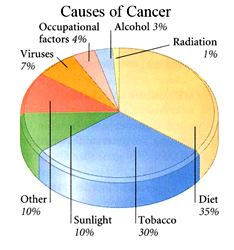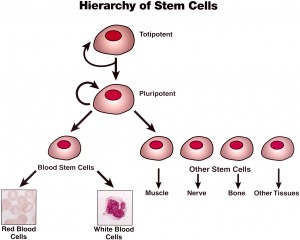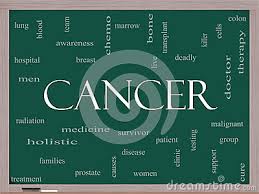Cancer is a disorder of the DNA. Some damage has caused a cell to start dividing in an uncontrolled fashion. Sin
ce the damaged DNA is replicated in cell division, the process continues, eventually forming a tumor. DNA damage is usually due to some sort of cellular stress. Some can be controlled and some cannot. The body has numerous defenses against cancer. A successful tumor must thwart them all to become life threatening.
This is the first in a 3 part series, discussing Cancer Initiation and Progression. The next post in the series, part 2, discusses Diagnosis and Prognosis. Part 3 explains how various lifestyle choices can affect cancer.
Like atherosclerosis, adult onset diabetes, and osteoporosis cancer can be prevented and at the earlier stages, reversed. In fact almost all cancer is eradicated by the immune system long before it forms a tumor large enough to be detected or cause damage.
A cancerous cell is one that is damaged at the DNA level and is replicating the damage. These cells must be killed or otherwise immobilized, either via the immune system or by medical intervention such as surgery and chemotherapy. Repair isn’t really possible here.
Many people are unaware that the immune system can fight cancer at all. In fact, it is the first line of defense and prevents almost all damaged cells from going very far awry. Natural killer cells, a type of immune system white cell, are patrolling for errant cells. In fact, for a cell to become cancerous, the natural killer function has to be thwarted, along with quite a few other things.
One might think that DNA, redundant, protected, and tucked away in the cell nucleus, is pristine and reliable. This is not the case. Damage to the DNA is common. Something like 60,000 repairs are made to a single cell’s DNA daily. Multiply this by the 100 trillion cells and you get some idea of the astronomical level of DNA repair that is continually going on.
Heart disease and Adult Onset Diabetes are mainly caused by inappropriate lifestyle choices. However, cancer has a variety of causes and many of them are not under our control:
· Smoke
· Ultra-violet light from the sun
· Toxic materials in the food chain
· Air pollution
· Water pollution
· Radiation from radioactive materials or the cosmos
· X-rays
Infections can also play a role. We will not address this as it can get very specific and become misleading.
 Cancer and DNA damage can also be initiated by several factors within our control. A diet lacking in nutrients could weaken cells, as could an imbalance of various cellular biochemicals, or an overabundance of free-radicals. Chronic stress levels and poor sleep patterns diminish the immune system’s natural cancer fighting ability.
Cancer and DNA damage can also be initiated by several factors within our control. A diet lacking in nutrients could weaken cells, as could an imbalance of various cellular biochemicals, or an overabundance of free-radicals. Chronic stress levels and poor sleep patterns diminish the immune system’s natural cancer fighting ability.
Repairing Cellular Damage
Regardless of the source of the damage, the cell has considerable machinery available to attempt a repair. Like any other cellular function, cellular health is a prerequisite for efficient performance of this activity. Now DNA is famously composed of a double strand of complementary nucleotides. So if a single strand is damaged, it can be replaced by using the undamaged complementary piece as a template. This assumes, of course, that the cell knows which strand is the undamaged one. It usually gets this right, but how exactly isn’t really known in complete detail.
On the other hand, some sorts of DNA damage are not reparable, for instance, a double strand break. This is a dangerous one. The blueprint for possible reconstruction is obliterated. The typical repair consists of tossing out the broken section and rejoining the broken strands. This isn’t so much a repair as a cellular kluge, and clearly, that strand might cause problems. Almost always, such a cell won’t make it through the next cell division, but if it does, we now have two new maverick cells, with unknown intent, that can replicate, again a candidate for tumor generation.
The ‘standard procedure’ for these un-repairable cases is for the cell to commit suicide, called apoptosis, or else just sort of fizzle out, called senescence. Of course, the cell has to be functioning well enough to do this, which is an obvious weak spot. Cells that don’t follow the ‘rules’ are tumor candidates.
Most Cancers Start In Stem or Progenitor Cells
A single damaged cell may do goofy things, but is unlikely to cause any harm unless it can divide. After all, it’s only one of a hundred  trillion. Normally only stem and progenitor cells have the ability to divide. See the Stem Cell Basics – Replacement Organs post for more info. As stem cells differentiate down toward their working everyday versions, the ability to divide is lost. Likewise, many cells are around for life, and there is little division going on there.
trillion. Normally only stem and progenitor cells have the ability to divide. See the Stem Cell Basics – Replacement Organs post for more info. As stem cells differentiate down toward their working everyday versions, the ability to divide is lost. Likewise, many cells are around for life, and there is little division going on there.
Thus, where you find the cancers is mostly where you find the stem and progenitor cells, and you find these associated with tissues that renew, like skin, the intestines, colon, lungs, throat, and so on. Cancer is far less common in the permanent cells, like the brain, the heart, muscle, etc. (Actually brain cancer almost always involves a cancer that has started somewhere else and taken up residence in the brain, i.e. metastasized, or a cancer from the glial cells, the part of the brain that provides the structure for the neurons, and does in fact divide.)
Stem and progenitor cells are usually as protected as they reasonably can be. The ones for the skin are under several skin layers, (note from guy with Cheap English Skin: not enough layers to protect from the California sun) those for the intestine are in little intestinal cubbyholes called ‘crypts’, safely away from the caustic intestinal lumen. The white and red blood cells are generated in the middle of bones. Hard to get more protected than that.
A Sequence of Mutations Are Needed To Launch A Cancer
Given how many things have to go wrong to get a life-threatening tumor, you would think it could never happen. Of course, we know otherwise, but consider the sequence of events required:
1. A mutation in a cell’s DNA needs to happen. We have already discussed numerous causes for this.
2. This mutation has to cause uncontrolled division. Most mutations are completely unrelated to division.
3. Various cellular mechanisms specifically designed to block unregulated proliferation must be disabled.
4. A mutation must also thwart the cellular mechanisms that cause programmed cell death – apoptosis.
5. The mutation must similarly block senescence.
6. The mutation has to deceive the meandering white cells that are looking for cell abnormalities. Specifically the mutated cell has to display a certain protein indicating that it is intact and normal, when it fact it is not.
7. Angiogenesis. This is a key step. The cells may begin proliferating, but they need to eat. Where is the blood supply? Blood can diffuse about half a millimeter at most, which limits the tumor growth to about the size of this “o”. Any further division will stall out from lack of nutrients. Another mutation is needed at this point to start producing an enzyme that causes new blood vessels to grow. This is called angiogenesis.
8. Now the tumor can grow, possibly quite large, but it may not yet be life threatening. In fact, a tumor bigger than a raisin can be spotted with an MRI – provided one is done. But people aren’t routinely scanned. If there is a symptom, some pain for instance, then there might be a scan, and if a contained tumor is discovered, it will probably be successfully removed or eradicated. So if the tumor is to progress further, it will need to maintain a stealthy symptom free profile.
9. To continue its lethal course, the tumor must now metastasize. So the next mutation is one that will allow tiny pieces of the tumor to detach and enter the bloodstream or the lymph system. Note that this step would be easy for any sort of cell that normally circulates in either system. This is the situation with leukemia, where the leukocytes (white blood cells) have become cancerous.
10. The bloodstream and lymph system are fairly loaded with immune cells, so the cancer will have to have a way to evade detection there.
11. Still another mutation is needed to enable the tumorous material to burrow back out of the bloodstream or lymph system and inflict itself on some other organ.
12. Depending on where the metastatic tumor material landed, additional mutation may be needed in order for it to thrive further.
So why do we ever get cancer? The odds are small, but the number of cells is high, so the rare sequences do happen. In a sense, we always have cancer. In anyone’s body, hundreds of thousands, perhaps millions of tiny cancers are at various stages of development. How far any of them get depends a lot on cellular health, mitochondrial health, and an active immune system. And all of this is strongly influenced by lifestyle choices.
Many anti-cancer therapies attempt to block one of these steps. For example if angiogenesis, the production of new blood vessels, can be blocked, the cancers are stuck at a small non-lethal size. On the other hand if angiogenesis is completely blocked the host, that would be the patient, also dies.
Here is a list of the future posts on cancer. Stay tuned.
Cancer Basics – Part 1 – Initiation and Progression
Cancer Basics – Part 2 – Diagnosis and Prognosis
Cancer Basics – Part 3 – Prevention

My Son was diagnose with Lymph Cancer yesterday. There are a tumour 10x12x21 under his skin by his chest. And his Lymph notes under his arms and legs are swollen. Is this a death Sentence and can it be cured? Docters are planning to remove this tomorrow.
Hi Joe,
I am so sorry you and your family and son are living through this. I will tell you what you must surely know: I cannot possibly comment on your son’s case in a blog format. My refusal to speculate is NOT because I am withholding some terrible news, my refusal is based on the simple fact that I cannot possibly know enough about your son’s case to make useful remarks. God’s Peace and Hope and Healing be with you and your son this day and everyday. Dr. Mike
“One World One Health One Medicine” Let’s get control of Human Zoonosis—INTERNAL PARASITES which robs the body of essential nutrients, release toxins into the body, thus depressing the immune system, body cells (DNA) mutate
the body knows something is foreign, forms a cyst/mass
Cancerous Lesion/Tumor
Please perform a feces exam on one and all for Internal Parasites
a study that I have conducted since 1984
In August 2015 I had a flu symptom and felt a few painless lump in the neck. I consulted a GP from my company who put me on antibiotic for review a week later.
After 1 week, those lump remain the same and the GP put me on another course of antibiotic and a referral letter to Singapore General Hospital Otolaryngology (ENT) dept. on 9th Sept. 2015.
I was advice to consult a Singhealth Polyclinics GP for another referral letter so that I could benefit from Government subsidies as it would be very costly with the referral letter issued by GP from my company. The new appointment date was delay to 15th January 2016.
Today, 18th November 2015 I saw an article in a news paper regarding Nasopharyngeal cancer. It stated that one of the symptoms to look out for possible signs of Nasopharyngeal cancer is a painless lump in the neck (three in four newly diagnosed patients have this symptom).
Now i’m a little concern because the lump in my neck is still there and maybe subconsciously I feel the lump had grown slightly bigger then before.
What do you think I should do? I’m worry that the hospital might tell me that I’m having some types of cancer and it has reach 3rd, 4th or finial stage, if I were to wait till my appointment date. I did tried calling the Hospital to ask for a earlier day but till now still not possible,
Your work is so good
Welldone stop cancer mishan